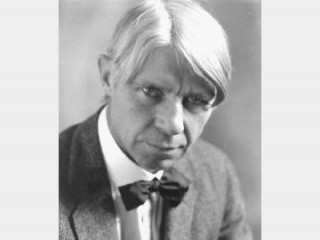
Carl Sandburg biography
Date of birth : 1878-01-06
Date of death : 1967-07-22
Birthplace : Galesburg, Illinois
Nationality : American
Category : Famous Figures
Last modified : 2011-01-26
Credited as : Anthologist and poet, folk singer, and biographer
An American poet, anthologist, singer of folk songs and ballads, and biographer, Carl Sandburg (1878-1967) is best known for his magnificent biography of Abraham Lincoln and his early "realistic" verse celebrations of Chicago.
The legend of Carl Sandburg as a raw, folksy poet of midwestern democracy has overshadowed his later development. From the time he wrote his moving elegy on the death of Franklin D. Roosevelt, "When Death Came April Twelve 1945," until his final volume of poetry, Honey and Salt (1963), he exhibited a newly achieved depth and originality that far surpassed his earlier work. His youthful career as an impassioned revolutionary socialist has largely been forgotten, and he died one of America's best-known and best-loved poets.
Sandburg was born in Galesburg, Ill., on Jan. 6, 1878, of a poor Swedish immigrant family. At the age of 13 he quit school to work as a day laborer. He traveled extensively through the West, where he began developing a lifelong devotion to his country and its people. Following Army service during the Spanish-American War, he entered Lombard (now Knox) College in Galesburg. Here he wrote his first poetry.
After graduation Sandburg worked as a newspaperman in Milwaukee, Wis. In 1907 and 1908 he was district organizer for the Social Democratic party in Wisconsin and served as secretary to Milwaukee's Socialist mayor (1910-1912). Later he moved to Chicago, becoming an editorial writer for the Daily News in 1917. Meanwhile his verse began appearing in the avant-garde Poetry magazine; his first volume, Chicago Poems, was published in 1916. His reputation as vital poet of the American scene was solidified with Cornhuskers (1918), Smoke and Steel (1920), and Slabs of the Sunburnt West (1922).
Early Writings
Sandburg's early poetry was as close to being "subliterary" as the work of any American poet of comparable stature. Meant to illustrate his humanitarian socialist ideology, his early verse is scarcely above the level of political oratory. "I Am the People, the Mob" from the Chicago Poemsis characteristic. The ending of the poem is reminiscent of Walt Whitman at his most prosaic: "When I, the People, learn to remember, when I, the People, use the lessons of yesterday and no longer forget who robbed me last year, who played me for a fool—then there will be no speaker in all the world say the name: 'The People,' with any fleck of a sneer in his voice or any far-off smile of derision. The mob—the crowd—the mass—will arrive then."
Neither in use of language nor in metrics does this qualify even as free verse; in style it is closer to John Dos Passos' contemporary experiments in prose than to poetry. The revolutionary naturalistic esthetic of the time called for a poetry of direct imitation; but Sandburg's "imitations" exhibited little artistry.
Sandburg's early poetry not only tended toward excessively unshaped imitation of reality but also copied other poets as well. T. S. Eliot's "The Love Song of J. Alfred Prufrock" had appeared the year before Sandburg's "Fog" was published. Eliot's image of the fog as a cat has profound implications in the context of the rest of his poem; "Fog," which was hailed as a fine example of an imagist poem, has no context whatsoever and hence no meaning. In terms of imagist poetics, "Fog" might be considered successful, but Sandburg had never counted himself a member of that movement; nor had he ever seriously considered its esthetic.
Similarly, Sandburg's "Happiness" compares unfavorably with Ezra Pound's "Salutation," and his "Buffalo Bill" expresses mere nostalgia in relation to E. E. Cummings's more penetrating "Buffalo Bill's." Some of the poems in Cornhuskers are more original and fully realized than those discussed here, but none meets the standards of the best of his contemporaries.
From 1926 to 1939 Sandburg devoted himself primarily to writing the six-volume biography of Abraham Lincoln, presenting Lincoln as the embodiment of the American spirit; he received a Pulitzer Prize in history for this work (1939). He also was collecting the folk songs that made up The American Songbook (1927).
Honey and Salt (1963), a remarkable achievement for a "part-time" poet in his 80s, contains much of Sandburg's best poetry. Here the mellowness and wisdom of age are evident; the sound of an American idiom echoes through these poems more effectively than in the earlier "realistic" verse. By this time Sandburg had moved from his dependence on ideology to a deeply felt sympathy and concern for actual people. Tenderness replaces sentimentality; emotional control replaces defensive "toughness." There is an explicitly religious consciousness in these last poems, only implicit in the earlier work, where it was often submerged in political ideology and naturalistic poetics.
Sandburg also published a collection of children's stories, Rootabaga Stories (1922). Other volumes of poetry are Good Morning, America (1928); The People, Yes (1936); Collected Poems (1950), which won a Pulitzer Prize; and Harvest Poems, 1910-1960 (1960). Remembrance Rock (1948), an epic panorama of American history, was his only novel. He died in Flat Rock, N.C., on July 22, 1967.
Sandburg's autobiography is Always the Young Strangers (1953). A biography is Harry L. Golden, Carl Sandburg (1961). Good critical commentary includes "Carl Sandburg's Complete Poems" in William Carlos Williams, Selected Essays (1954); Newton Arvin's "Carl Sandburg" in Malcolm Cowley, ed., After the Genteel Tradition: American Writers since 1910 (1959); Roy Harvey Pearce, The Continuity of American Poetry (1961); and Hyatt H. Waggoner, American Poets: From the Puritans to the Present (1968).
















